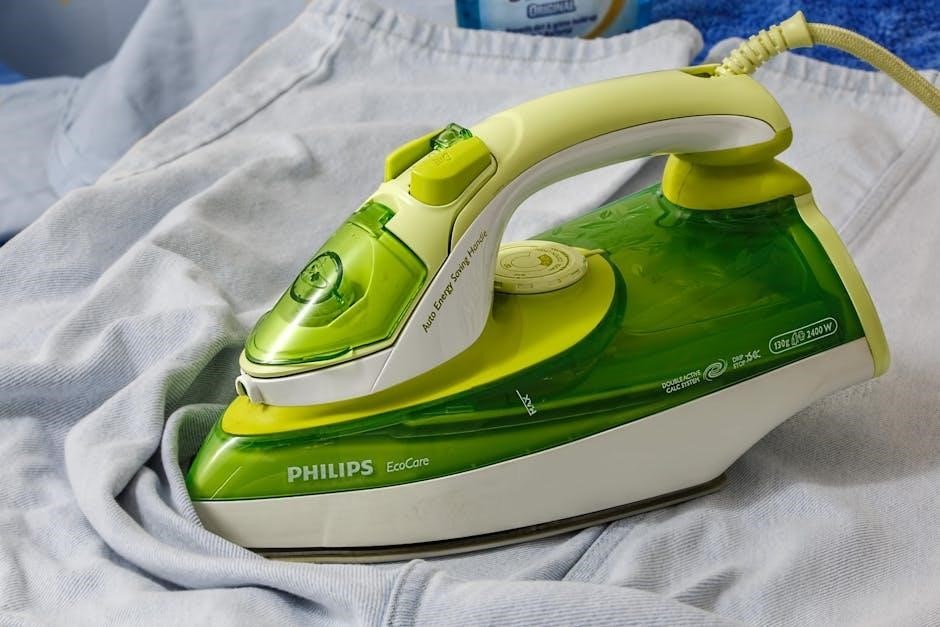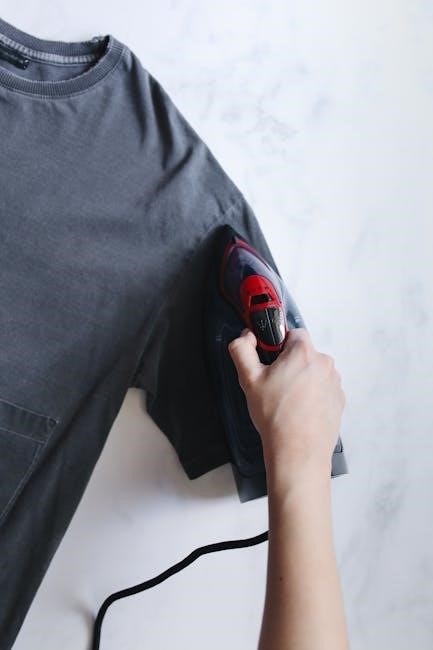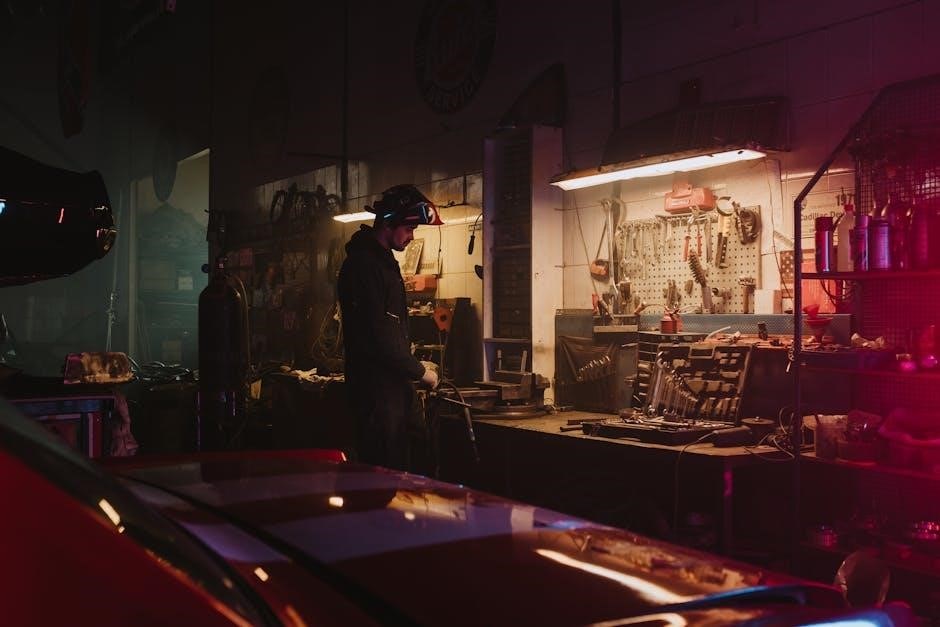Manual and electric chokes are essential components in carburetors, designed to enrich the air-fuel mixture during engine warm-up․ While manual chokes require driver input, electric chokes operate automatically, offering convenience and efficiency․
1․1 Overview of Manual and Electric Chokes
A manual choke is a mechanical device that requires the driver to adjust the choke valve manually, typically via a cable․ It is commonly found in older vehicles or performance-oriented setups, offering direct control over the air-fuel mixture during engine warm-up․ Electric chokes, on the other hand, operate automatically using an electric current, usually sourced from the vehicle’s battery․ They often include a bi-metallic strip that responds to temperature changes, eliminating the need for manual intervention․
Both systems serve the same purpose—to enrich the fuel mixture when the engine is cold—yet they differ in operation and convenience․ Manual chokes provide simplicity and reliability, while electric chokes offer ease of use and modern functionality․ Understanding these differences is crucial for maintaining and optimizing engine performance in various driving conditions․
1․2 Importance of Understanding Choke Systems
Understanding choke systems is crucial for optimal engine performance and longevity․ Both manual and electric chokes play a vital role in managing the air-fuel mixture during engine warm-up, ensuring efficient combustion․ Proper operation prevents issues like rough idling or hard starting, which can lead to premature wear on engine components․ Misconfigured or malfunctioning chokes can result in poor fuel efficiency, reduced power, and increased emissions․ Additionally, knowing how to troubleshoot and maintain these systems saves time and money․ For enthusiasts modifying their vehicles, understanding the differences between manual and electric chokes helps in making informed decisions during upgrades or conversions․ This knowledge also empowers users to diagnose and resolve common problems effectively, enhancing overall driving experience and engine reliability․

Definitions
A manual choke is operated via a cable or knob, requiring physical adjustment to regulate airflow․ An electric choke uses voltage to automatically control the choke valve, eliminating manual intervention․
2․1 What is a Manual Choke?
A manual choke is a component used in carburetors to regulate the airflow by enriching the air-fuel mixture during engine startup and warm-up․ It is typically operated by a cable or knob connected to the driver, allowing manual control․ When activated, the choke valve restricts airflow, increasing the fuel-to-air ratio for easier cold starting․ This mechanism requires driver input, as it must be opened gradually as the engine warms up․ Manual chokes are commonly found in older vehicles and aftermarket carburetors, such as Holley models․ They are known for their simplicity, reliability, and lack of automation, making them a preferred choice for enthusiasts who value control over engine performance․ Unlike electric chokes, manual chokes do not rely on temperature sensors or electrical systems, ensuring straightforward operation and minimal potential for failure․
2․2 What is an Electric Choke?
An electric choke is a carburetor component that automatically regulates the airflow to the engine during warm-up․ Unlike manual chokes, electric chokes are controlled by an electric coil that responds to temperature changes․ When the engine is cold, the coil energizes, closing the choke valve to enrich the air-fuel mixture․ As the engine warms up, the coil de-energizes, allowing the choke to open gradually․ This automatic operation eliminates the need for manual adjustment, providing convenience and consistency․ Electric chokes are typically powered by the vehicle’s electrical system, requiring a specific voltage supply to function properly․ They are often preferred for their ease of use and modern design, though they can malfunction if not maintained․ Electric chokes are commonly found in aftermarket carburetors, such as Holley models, and are popular for their reliability and seamless integration with engine systems․

Operation
3․1 How Manual Chokes Work
A manual choke operates via a cable connected to a knob, allowing the driver to manually adjust the choke valve for engine warm-up․
3․2 How Electric Chokes Work
An electric choke uses an electric current to automatically open the choke valve as the engine warms, eliminating the need for manual adjustment․
A manual choke operates through a cable or lever controlled by the driver; When the engine is cold, the driver pulls the choke knob, closing the choke valve in the carburetor․ This restricts airflow, enriching the air-fuel mixture to aid cold starting․ As the engine warms, the driver gradually opens the choke, allowing more airflow and leaning out the mixture․ The process requires driver input and awareness of engine temperature․ Proper adjustment is crucial; too much choke can cause richness, while too little may prevent proper starting․ Manual chokes rely on mechanical simplicity, making them reliable and easy to maintain․ They are often preferred in performance setups for precise control․ However, they require consistent monitoring, as improper use can lead to poor engine performance or difficulty starting․ Overall, manual chokes provide a straightforward, driver-managed solution for engine warm-up and operation․
Electric chokes operate automatically, eliminating the need for manual adjustment․ They use an electric coil that responds to voltage changes․ When the engine is cold, the choke valve remains closed, restricting airflow and enriching the air-fuel mixture․ As the engine warms up, the coil heats up, opening the valve gradually․ This process is controlled by the vehicle’s electrical system, ensuring the choke opens fully when the engine reaches operating temperature․ Unlike manual chokes, electric chokes do not require driver input, providing convenience․ However, they rely on proper electrical connections and temperature sensing to function correctly․ If the system malfunctions, it can lead to poor engine performance․ Electric chokes are designed to simplify the starting and warming process, making them a popular choice for modern vehicles․ Their automatic operation ensures consistent performance, but they can sometimes activate even when not needed, depending on the system’s calibration․

Advantages
4․1 Advantages of Manual Chokes
Manual chokes are cost-effective, simple, and reliable, offering precise control over the air-fuel mixture during engine warm-up․
4․2 Advantages of Electric Chokes
Electric chokes provide automatic operation, eliminating manual intervention, and ensure consistent performance across varying temperature conditions․
Manual chokes offer several advantages, making them a popular choice for many enthusiasts․ One key benefit is their cost-effectiveness, as they are generally cheaper to purchase and maintain compared to electric chokes․ They are also less prone to malfunctions since they rely on a simple mechanical system rather than electrical components․ This simplicity reduces the risk of failure and makes them easier to troubleshoot․ Additionally, manual chokes provide drivers with more control over the air-fuel mixture, allowing for precise adjustments during engine warm-up․ They are often preferred in performance-oriented setups, as they can be fine-tuned for optimal performance․ Furthermore, manual chokes do not require any electrical connections, making them a reliable option in vehicles with complex or unreliable electrical systems․ Overall, manual chokes are a straightforward, durable, and cost-efficient solution for engine management․
Electric chokes offer significant advantages, primarily their automatic operation, eliminating the need for manual adjustment․ This convenience ensures proper air-fuel mixture enrichment during engine warm-up without driver input․ They are highly reliable and maintain consistent performance across varying conditions․ Electric chokes also reduce the risk of human error, as they are controlled by temperature sensors, ensuring the choke opens and closes at the optimal time․ Additionally, they are less prone to wear and tear compared to manual chokes, as there are no cables or mechanical linkages to degrade․ Their seamless integration with modern engines makes them a preferred choice for many vehicle owners․ However, while they provide excellent functionality, they may lack the tunability of manual chokes, which can be a drawback for performance enthusiasts․
Disadvantages
Manual chokes can malfunction due to worn cables or connectors, requiring frequent adjustments․ Electric chokes may fail unexpectedly, causing poor engine performance, and depend on electrical systems, which can be unreliable․
5․1 Disadvantages of Manual Chokes
Manual chokes require constant driver interaction, which can be inconvenient, especially for those unfamiliar with their operation․ They demand precise adjustment during engine warm-up, and improper use can lead to poor engine performance․ The lack of automation means drivers must remember to open the choke gradually, which can be error-prone․ Additionally, manual chokes rely on mechanical components like cables and springs, which are prone to wear and tear, potentially leading to reliability issues․ Maintenance is also more hands-on, as users must ensure the choke mechanism functions correctly․ Furthermore, manual chokes may not adapt well to varying temperatures or driving conditions, requiring more effort from the driver․ Overall, while they offer simplicity, their need for manual control and higher maintenance make them less convenient compared to electric chokes․
5․2 Disadvantages of Electric Chokes
Electric chokes have several drawbacks that can affect their performance and reliability․ One major disadvantage is their dependence on the vehicle’s electrical system, which can fail or malfunction, leaving the choke inoperable․ Additionally, electric chokes are more complex and expensive to repair compared to manual versions․ They can also be prone to issues such as incorrect voltage supply, which may cause the choke to open or close improperly․ Another concern is their automatic operation, which may not always align with the engine’s actual needs, potentially leading to poor performance during warm-up․ Furthermore, electric chokes can be less durable in harsh environments due to their sensitive electronic components․ While they offer convenience, these downsides make them less favorable for drivers seeking simplicity and reliability․

Maintenance
Manual chokes require regular cleaning of the choke valve and ensuring smooth operation․ Electric chokes need checking of the heating element and electrical connections for proper function․
6․1 Maintaining Manual Chokes
Maintaining a manual choke involves regular cleaning and adjustment to ensure proper function․ Start by removing and inspecting the air cleaner to access the choke․ Clean any dirt or debris from the choke valve and surrounding areas using a soft brush or compressed air․ Check the choke cable for smooth operation and adjust its tension if necessary․ Over time, the choke valve may wear out, requiring replacement․ Ensure the choke blade closes completely when the engine is cold and opens fully as it warms up․ If the choke hesitates or sticks, lubricate the pivot points lightly․ Proper maintenance ensures consistent performance, especially during cold starts․ Regularly monitoring the choke’s condition prevents issues like rough idling or difficulty starting the engine․
6․2 Maintaining Electric Chokes
Maintaining electric chokes involves periodic inspections and adjustments to ensure proper functionality․ First, check the voltage supply to the electric choke, ensuring it matches the manufacturer’s specifications․ Next, inspect the electrical connections for any signs of wear or corrosion, as faulty connections can disrupt operation․ Clean the choke housing and surrounding areas to prevent dirt buildup, which may interfere with its ability to open and close smoothly․ Additionally, verify that the choke operates correctly when the engine is cold, fully closing to enrich the air-fuel mixture․ If issues arise, such as delayed opening or failure to close, consider replacing the choke coil or entire unit․ Regular maintenance helps prevent malfunctions and ensures optimal engine performance during startup and warm-up․
Conversion Processes
Converting a manual to electric choke involves installing an electric choke unit and connecting it to the vehicle’s electrical system․ Conversely, switching from electric to manual requires replacing the electric choke with a manual mechanism and adjusting the carburetor accordingly․
7․1 Converting from Manual to Electric Choke
Converting from a manual to an electric choke offers the convenience of automatic operation․ Start by disconnecting the manual choke cable from the carburetor․ Next, install the electric choke unit, ensuring it is compatible with your carburetor type․ Connect the choke’s electrical connector to a 12V power source, typically linked to the ignition switch for activation during engine startup․ Adjust the choke housing to ensure proper alignment and function․ Finally, test the system to confirm the choke opens and closes smoothly as the engine warms up․ This conversion eliminates manual adjustments, providing easier cold starts and improved reliability․ Proper installation is crucial to avoid performance issues․
7․2 Converting from Electric to Manual Choke
Converting from an electric to a manual choke involves several steps․ First, disconnect the electrical connector from the electric choke to ensure no power is supplied during the process․ Next, remove the electric choke mechanism, which may require a screwdriver or wrench․ Once removed, install a manual choke in its place, ensuring it is securely fastened․ Attach a manual choke cable, routing it to an accessible location, such as the dashboard or steering column, for easy adjustment․ Adjust the choke housing by loosening the screws to allow the choke blade to move freely․ Finally, test the conversion by starting the engine and adjusting the manual choke to ensure smooth operation․ Proper tension on the cable is crucial to avoid issues with the choke opening or closing correctly․ Always follow safety precautions, such as disconnecting the battery and ensuring the engine is cool, before beginning the conversion․

Performance Comparison
Electric chokes offer automatic operation, eliminating manual adjustment, while manual chokes provide precise control․ Electric chokes can sometimes engage unnecessarily, whereas manual chokes rely on driver input for optimal performance․
8․1 Performance of Manual Chokes
Manual chokes deliver reliable performance, especially in cold-start situations, by allowing drivers to manually enrich the air-fuel mixture․ This direct control ensures precise adjustment, which can be advantageous for drivers seeking optimal engine response․ However, manual chokes require constant monitoring and adjustment, which can be inconvenient․ They are often preferred in older vehicles or performance setups where simplicity and reliability are prioritized․ A key benefit is their ability to provide a richer mixture when needed, improving idle stability and reducing hesitation during warm-up․ However, improper adjustment can lead to poor performance, such as a too-rich mixture causing stumbling or a too-lean mixture resulting in rough idling․ Overall, manual chokes offer consistent performance for those willing to engage with their operation․
- Provides precise control over air-fuel mixture․
- Reliable in cold-start conditions․
- Requires manual intervention and adjustment․
- Less convenient compared to automatic systems;
8․2 Performance of Electric Chokes
Electric chokes offer seamless performance by automatically adjusting the air-fuel mixture based on engine temperature, eliminating the need for manual intervention․ This hands-off operation enhances convenience, especially in modern vehicles where drivers prefer minimal input․ Electric chokes ensure the choke valve opens and closes gradually, preventing abrupt changes that could cause engine stumbling․ They also adapt well to varying operating conditions, maintaining optimal performance across different temperatures․ However, reliance on electrical systems can lead to malfunctions if wiring or sensors fail․ Additionally, some users report that electric chokes may activate even when unnecessary, slightly reducing efficiency․ Despite this, their automatic nature makes them a preferred choice for everyday driving, providing consistent and reliable engine behavior during warm-up and operation․
- Automatic adjustment for convenience․
- Smooth operation during engine warm-up․
- Dependence on electrical systems․
- Potential for unnecessary activation․

Troubleshooting Common Issues
Troubleshooting manual and electric chokes involves checking for proper function, adjusting or replacing faulty components, and ensuring electrical connections are secure for electric models․ Regular maintenance is key․
9․1 Troubleshooting Manual Choke Issues
Troubleshooting manual choke issues often involves identifying problems with the choke valve, cable, or linkage․ Common issues include the choke not closing properly, resulting in a lean air-fuel mixture, or the cable sticking due to wear or corrosion․ If the engine struggles to start when cold, it may indicate the choke is not functioning correctly․ To diagnose, inspect the choke cable for damage or fraying and ensure it moves freely․ Check the choke valve for proper alignment and operation․ Adjusting the choke cable tension or replacing worn components can often resolve these issues․ Additionally, ensure the choke housing is not loose, as this can affect performance․ Regular lubrication of moving parts and cleaning the choke area can prevent malfunctions․ If problems persist, consulting a repair manual or seeking professional assistance is recommended․
9․2 Troubleshooting Electric Choke Issues
Troubleshooting electric choke issues often involves diagnosing electrical or mechanical faults․ Common problems include the choke not opening or closing properly, which can result from incorrect voltage supply or faulty wiring․ If the choke remains closed, the engine may struggle to start or run rich․ Conversely, a stuck-open choke can cause lean mixtures and poor warm-up performance․ Checking the voltage supply to the choke (typically 12V) is a good first step․ If the voltage is correct, inspect the wiring and connections for damage or corrosion; A malfunctioning temperature sensor or choke coil can also cause issues․ In some cases, the choke may need to be manually adjusted or replaced․ Regular maintenance, such as cleaning the choke housing and ensuring proper airflow, can prevent many of these problems․ Addressing these issues promptly ensures reliable engine performance and proper fuel mixture during warm-up․